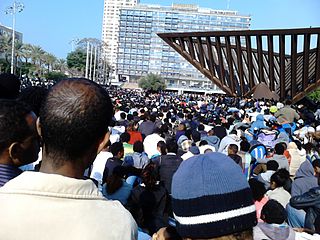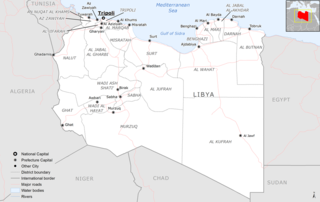Related Research Articles

The Sinai Peninsula, or simply Sinai, is a peninsula in Egypt, and the only part of the country located in Asia. It is between the Mediterranean Sea to the north and the Red Sea to the south, and is a land bridge between Asia and Africa. Sinai has a land area of about 60,000 km2 (23,000 sq mi) and a population of approximately 600,000 people. Administratively, the vast majority of the area of the Sinai Peninsula is divided into two governorates: the South Sinai Governorate and the North Sinai Governorate. Three other governorates span the Suez Canal, crossing into African Egypt: Suez Governorate on the southern end of the Suez Canal, Ismailia Governorate in the center, and Port Said Governorate in the north.

The Rashaida, also known as Bani Rasheed, are a Bedouin ethnic group inhabiting the coastal plain of the Red Sea stretching from the Sudanese city of Port Sudan to the Eritrean city of Massawa. They are the descendants of Arab tribes people from Hejaz, and Najd decending from the Banu Abs tribe, who fled the Arabian peninsula in 1846 as the Saudis rose to power. They are mostly nomadic and constitute 187,500 people in Eritrea and 168,000 people in Sudan, mainly in the eastern part around Kassala.

Eritreans are the native inhabitants of Eritrea, as well as the global diaspora of Eritrea. Eritreans constitute several component ethnic groups, some of which are related to ethnic groups that make up the Ethiopian people in neighboring Ethiopia and people groups in other parts of the Horn of Africa. Nine of these component ethnic groups are officially recognized by the Government of Eritrea.
Human trafficking in Israel includes the trafficking of men and women into the country for forced labor and sex slavery. The country has made serious efforts to reduce the problem in recent years and now ranks 90th out of 167 countries who provide data. Identification of victims, criminal justice work and efforts to co-ordinate with business and government agencies has been concerted in reducing this problem in the last decade.
Libya is a transit and destination country for men and women from sub-Saharan Africa and Asia trafficked for the purposes of forced labor and commercial sexual exploitation. While most foreigners in Libya are economic migrants, in some cases large smuggling debts of $500–$2,000 and illegal status leave them vulnerable to various forms of coercion, resulting in cases of forced prostitution and forced labor.

The Egypt–Israel barrier or Egypt–Israel border fence refers to a separation barrier built by Israel along its border with Egypt. Initial construction on the barrier began on 22 November 2010, and its original purpose as a common fence was to curb the large influx of illegal migrants from African countries into Israel. However, in the wake of the Egyptian Crisis after the 2011 Revolution, Israel's southwestern border with Egypt experienced an increase in militant jihadist activity with the outbreak of the Sinai insurgency. In response, Israel upgraded the steel barrier—called Project Hourglass by the Israel Defense Forces (IDF)—to include cameras, radars, and motion detectors. In January 2013, construction on the barrier's main section was completed; the final section was completed in December 2013.

Sudanese refugees in Israel refers to citizens of Sudan who have sought refuge in Israel due to military conflict at home, and to those who moved there illegally as migrant workers. In 2008, there were 4,000 Sudanese in Israel, 1,200 from Darfur and the remainder Christians from South Sudan. The majority entered through the Israeli-Egypt border. Most live in Tel Aviv, Arad, Eilat and Bnei Brak.

African immigration to Israel is the international movement to Israel from Africa of people that are not natives or do not possess Israeli citizenship in order to settle or reside there. This phenomenon began in the second half of the 2000s, when a large number of people from Africa entered Israel, mainly through the then-lightly fenced border between Israel and Egypt in the Sinai Peninsula. According to the data of the Israeli Interior Ministry, 26,635 people arrived illegally in this way by July 2010, and over 55,000 by January 2012. In an attempt to curb the influx, Israel constructed the Egypt–Israel barrier. Since its completion in December 2013, the barrier has almost completely stopped the immigration of Africans into Israel across the Sinai border.
The U.S. State Department's Office to Monitor and Combat Trafficking in Persons placed Eritrea in "Tier 3" in 2017. Tier 3 countries do not fully comply with the minimum standards and are not making significant efforts to do so. In 2010 the U.S. Department of State reported that:
Eritrea is a source country for men, women, and children subjected to trafficking in persons, specifically conditions of forced labor and, to a lesser extent, forced prostitution. During the reporting period, acts of forced labor occurred in Eritrea, particularly in connection with the implementation of the country's national service program. Under the parameters set forth in Proclamation of National Service, men aged 18 to 54 and women aged 18 to 47 are required to provide 18 months of military and non-military public works and services in any location or capacity chosen by the government....
Eritrean children work in various economic sectors, including domestic service, street vending, small-scale factories, and agriculture; child laborers frequently suffer abuse from their employers and some may be subjected to conditions of forced labor. Some children in prostitution are likely exploited through third party involvement....
Each year, large numbers of Eritrean workers migrate in search of work, particularly to the Gulf States and Egypt, where some become victims of forced labor, primarily in domestic servitude. Smaller numbers are subjected to forced prostitution. In 2009, for example, five Eritrean trafficking victims were identified in the United Kingdom and one in Israel. In addition, thousands of Eritreans flee the country illegally, mostly to Sudan, Ethiopia, and Kenya, where their illegal status makes them vulnerable to situations of human trafficking.
The Saharonim Prison is an Israeli detention facility for African asylum seekers located in the Negev desert. It is the largest of a planned four camps with its total capacity of 8,000 inmates. Together with the Ktzi'ot prison, Sadot prison and the Nachal Raviv tent camp they detain South Sudanese, Sudanese and Eritrean asylum seekers who crossed the border from Egypt to Israel.

Sound of Torture is a 2013 documentary film written and directed by Israeli filmmaker Keren Shayo which follows Eritrean radio host and human rights activist Meron Estefanos as she reports on Eritrean refugees who have been captured in Sudan while migrating across the Sinai Peninsula into Israel.

Azezet Habtezghi Kidane is an Eritrean-born British nun and human trafficking activist working in Israel.
The Bani Walid detention camp is a secret prison in northwest Libya near the town of Bani Walid operated by human traffickers since at least 2009. Prisoners at the center often come from subsaharan Africa en route to Europe, and include adolescents and women. In order to extort their families, detention guards reportedly torture, rape, or threaten prisoners, who face similar conditions in other camps in the region. In May 2018, many Bani Walid prisoners attempted to escape, with most being shot or recaptured.
Human organ trafficking in Egypt, as of 2014 mainly practiced in Cairo and the Sinai Peninsula, includes organ harvesting with induced consent, coercion, and outright theft. Egypt has become the largest hub of organ transplant in North Africa as one of the few countries that prohibited organ donation from deceased donors until 2010, with over 500 kidney transplant operations a year and the majority of these organs come from living donors. Sources in the organ trafficking process mainly come from vulnerable populations including domestic rural migrants, undocumented asylum seekers and informal labor. The emergence of cultural and religious increase in organ trade and transplant tourism contribute to the rocketing demand for organ trafficking market in Egypt. Human organ trafficking poses both physical and mental health consequences for victims. Although Egypt has been gradually updating legal frameworks to combat organ trafficking, the regulation has failed in reality protecting survivors and governing transplant professionals.

The Hotline for Refugees and Migrants (Hotline) is a human rights organization that utilizes direct service provision, litigation, and advocacy to uphold the rights of refugees, migrant workers, and survivors of human trafficking in Israel. In Hebrew, the organization is known as המוקד לפליטים ולמהגרים (hamoked l'plitim v l'mehagrim).
The refoulement of Eritrean refugees consists of the forceful return of Eritrean refugees from Ethiopia back to Eritrea, while international law requires non-refoulement. The New York Times, Europe External Programme with Africa and Human Rights Concern Eritrea claimed that Eritrean refugees were forcefully returned to Eritrea during the Tigray War that started in late November 2020 from the Hitsats and Shimelba refugee camps. On 2 February 2021, there were 20,000 unaccounted for Eritrean refugees according to the United Nations High Commissioner for Refugees following a visit to Ethiopia.
Tewelde Goitom, or Walid or Welid, is an Eritrean human trafficker and smuggler.

Tachlowini Melake Gabriyesos is an Eritrean-born long-distance runner. He lives and trains in Tel Aviv, Israel, where he runs with the Emek Hefer club and is supported by an International Olympic Committee (IOC) Refugee Athlete Scholarship. He has competed over 3000 metres, 5000 metres, 10,000 metres, the half marathon, and the marathon. He finished in 16th place at the 2020 Olympics.

Detention centres in Libya are criminal enterprises run by gangs of human traffickers and kidnappers for profit. Lawlessness in Libya has resulted in circumstances where criminals gangs abduct and detain people who are migrating to or through Libya. 5,000 migrants are held in dozens of camps that are mostly located around Bani Walid. Detainees often suffer torture and may face execution if their family do not pay ransoms to the gangs.

Meron Estefanos is a Swedish-Eritrean human rights activist and journalist. She first became known in the Eritrean refugee community in 2011 for helping people who had been kidnapped and tortured by human traffickers on their way to Israel in order to extort ransom money from their relatives, exemplified in the 2013 documentary film Sound of Torture. After the migrant and trafficking routes changed to Libya, her efforts continued and uncovered criminal networks reaching into Europe. As of 2022, Estefanos deplored that no traffickers had been brought to justice, with little interest from national governments and international organisations.
References
- ↑ "Tortured for ransom: extortion on migrant routes". openDemocracy. 2016-10-05. Retrieved 2016-10-15.
- 1 2 3 4 Michael Obert (2013). "Im Reich des Todes". SZ Magazin (in German). 29.
- 1 2 Phoebe Greenwood (14 February 2012). "Egyptian authorities look the other way as Bedouin kidnap refugees". The Guardian.
- ↑ Mike Thomson (6 March 2013). "Sinai torture for Eritreans kidnapped by traffickers". BBC News.
- ↑ "Refugees disappearing from eastern Sudan may be trafficking victims – UN agency". UN News Centre. 25 January 2013.
- ↑ "Egypt/Sudan Refugees and Asylumseekers Face Brutal Treatment, Kidnapping for Rannsom, and Human Trafficking". Amnesty International. April 2013.
- ↑ Felix007.com. "Hotline for Refugees and Migrants. "The Dead of the Wilderness": Testimonies from Sinai Desert, 2010". hotline.org.il. Retrieved 2016-02-24.
{{cite web}}: CS1 maint: numeric names: authors list (link) - ↑ "Death in the Desert". CNN. 8 November 2011. Archived from the original on November 10, 2011.
- ↑ Physicians for Human Rights-Israel (23 February 2011). "Hostages, Torture, and Rape in the Desert: Findings from 284 Asylum Seekers about Atrocities in the Sinai" (PDF).
- 1 2 "Egypt: 'In Sinai, I saw hell'; refugees are easy prey for brutal human traffickers". Washington Times. 21 July 2013.
- ↑ Obert, Michael. "Sinai". obert.de (in German). Archived from the original on 2021-07-28. Retrieved 2019-10-25.
- 1 2 Shaw, Yowei (2013-08-09). "This Call May Be Recorded... To Save Your Life". This American Life. Retrieved 2016-10-15.
- ↑ "Lawless Sinai Shows Risks Rising in Fractured Egypt". The New York Times. 10 August 2013.